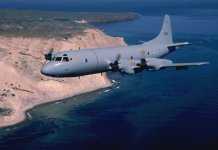Ukrainian President Volodymyr Zelenskyy and French President Emmanuel Macron on November 17 signed a Letter of Intent (LoI) that paves the way for the purchase of the SAMP/T next-generation air defense system and up to 100 Rafale jet fighters, as announced by the French Presidency and the Élysée Palace.
The development comes hours after Zelenskyy arrived at France’s Velizy-Villacoublay Air Base, where a Rafale jet was on display at the airport, meticulously placed in front of French and Ukrainian flags.
The two leaders were earlier expected to sign a wider defense agreement for air-defense systems, warplanes, and missiles.
“A historic agreement has been prepared with France – there will be a significant strengthening of our combat aviation, air defence, and other defence capabilities. According to the visit schedule, this will take place on Monday,” Zelenskyy had said in a post on X ahead of his meeting with Macron.
The letter of intent, which is not a purchase and sales contract, is projected to be realised “over a timeframe of about 10 years”, the French presidency added.
Earlier, some informed sources told Reuters that the two sides may be poised to sign a 10-year strategic aviation agreement that includes a provision for the sale of Rafale aircraft. They said that some of these jets could be supplied directly from France’s own stocks, but that the deliveries for the bulk of the order would be long-term.
Signature de lettre d’intention sur l’acquisition par l’Ukraine de Rafale et de systèmes SAMP/T NG. pic.twitter.com/vqMbLmklSv
— Élysée (@Elysee) November 17, 2025
However, the official statements have not disclosed any specific details of the talks or a future contract so far. The EurAsian Times has reached out to Dassault Aviation, the manufacturer of Rafale, for a comment, and this report will be updated with a response.
The announcement has been welcomed by Ukrainians.
“Ukraine and France sign a historic agreement – a declaration on Ukraine acquiring Rafale fighter jets, missiles for them, and SAMP/T air defense systems. Thank you, France!” said Anton Gerashchenko, the former advisor to Ukraine’s Internal Affairs Minister, in a post on X.
A previous statement released by the French President said Macron will “put French excellence in the armaments industry field at the service of the defense of Ukraine.
It stated that Paris will provide measures for Ukraine to acquire the systems that it needs to answer Russian aggression.” However, more details on the transfer of defense equipment that can be deployed against Russia are awaited.
Ukraine already operates the Mirage 2000-5F delivered by France last year. Last month, Macron promised to deliver additional Mirage 2000s (beyond the six already delivered) and Aster 30 surface-to-air missiles, which are fired from the SAMP/T air-defence batteries operated by Kyiv. The Mirage 2000s are used to thwart Russian aerial attacks.
The LoI for 100 Rafale aligns with Ukraine’s aspiration to assemble a 250-strong fighter jet fleet to deter Russia in the future.
Earlier, Zelensky said three fighter jets have been selected to modernize the Ukrainian Air Force: the F-16, Gripen, and Rafale. “I am conducting three parallel conversations regarding aircraft – with the Swedes, the French, and the Americans.”
Last month, Ukraine signed a letter of intent (LOI) during Zelensky’s visit to Sweden, marking a significant step toward acquiring 100-150 Saab JAS 39 Gripen E multirole fighter jets. The deal is described as Ukraine’s largest-ever combat aviation procurement and could position Kyiv as the world’s largest operator of the Swedish aircraft.
Notably, Ukraine had been eyeing the French Rafales even before the Russian invasion. In 2021, French President Emmanuel Macron offered Rafale to the Ukrainian Air Force. However, no progress was made, and Russia launched its full-scale invasion in February 2022, stalling any possibility of a deal.
Interest in the aircraft resurfaced when Ukrainian Foreign Minister Dmytro Kuleba referred to the Rafale as a “strategic long-term investment” in 2023. Unfortunately, the French Minister of Armed Forces, Sébastien Lecornu, ruled out the transfer of used Rafale aircraft in October 2024, stressing the need to maintain France’s own fleet amid a manufacturing timetable dominated by export obligations.
Ukraine’s Vision 2035 for its Air Force underscores that Kyiv fears a long-term threat to its nationhood from Russia, and even if a ceasefire is achieved in the coming years, it cannot let its guard down.
Notably, Ukraine’s European partners are now stepping up to help the embattled country build a powerful military so it has the resources to deter Russia once the grinding conflict ends. France, for one, has been at the forefront of assisting Ukraine against Russia and is likely to remain in that role for the foreseeable future.
Some experts exuded confidence that a purchase of Rafale could be game-changing for Ukraine, albeit with a caveat.
“If Ukraine’s purchase of Rafale fighter jets—the most cutting-edge aircraft available— without any restrictions on their use from France is confirmed, it would be a very significant step forward. A request that some of us have been making for a while. But time is of the essence,” Nicholas Tenzer, a senior fellow at CEPA (Centre for European Policy Analyses), wrote in a post on X.
An LoI is not a formal deal or binding contract; it merely sets the stage for formalizing a deal. Ukraine will become the ninth international buyer and the fourth European buyer of the French jet if Macron and Zelenskyy can work out a deal that benefits both sides.

Long Road to Ukraine’s Rafale Purchase
The Dassault Rafale is designed as a versatile “omnirole” platform, capable of performing air superiority, ground attack, reconnaissance, and even nuclear deterrence missions in a single sortie. Unlike single-role jets, it can seamlessly switch between tasks, making it highly adaptable for dynamic battlefields.
It is equipped with the Thales RBE2 Active Electronically Scanned Array (AESA) radar for superior detection and tracking of targets at long ranges (up to 200 kilometres), even in cluttered environments.
It also features the SPECTRA electronic warfare suite, which provides 360-degree threat detection, jamming, and decoy deployment to evade missiles and radar locks. Powered by two Safran M88 engines, it reaches Mach 1.8 speeds, has a combat radius of over 1,000 kilometers.
Rafale can carry up to 9.5 tons of payload on 14 hardpoints. One of the key advantages of the Rafale is its ability to employ the long-range air-to-air Meteor missile, developed by the MBDA consortium.
Meteor is one of the most lethal air-to-air missiles in service today. Furthermore, the Meteor missile is compatible with both the Rafale and the Gripen E, which is also expected to be acquired by Kyiv alongside the Rafale.
The French ace aircraft has proven itself in combat and recently achieved a remarkable milestone by locking onto an American F-35 stealth fighter during a mock drill held as part of the Trident Atlantic 25 exercise.
Since the Ukrainian Air Force already operates the F-16s and Mirage 2000-5F (considered a precursor to the French Rafale) fighters, there is a common perception that the service will be able to integrate the new F-16s and Rafales without much difficulty.
However, challenges persist in Ukraine’s acquisition of Rafale aircraft.

For one, the deliveries will take several years. Dassault currently has a backlog of 233 Rafale fighter jets, including 53 to France, and 180 for export customers.
Of the 233 airframes yet to be delivered, Dassault has to deliver 53 jets to France, 26 Rafales to Egypt, 26 Rafale M to the Indian Navy, 42 Rafales to Indonesia, 12 to Serbia, and 80 to the UAE. Furthermore, India can place an order for 114 additional Rafale fighter jets, as recently recommended by the Indian Air Force (IAF).
Dassault has streamlined its Rafale production rate to 36 per year. However, even with this rate, Dassault needs more than six years to fulfill its existing commitments. So, Ukraine will have to wait a long time, unless France prioritises deliveries to Kyiv. Therefore, it is believed that any acquisition would be a medium-term prospect at best and a long-term prospect at worst, rather than an immediate reinforcement.
The delivery of the jets might not commence before 2029, as per reports. Experts have flagged this as an issue, particularly because it would not benefit Kyiv in the ongoing war, and have called upon the leadership to focus on bolstering air defenses immediately.
Some analysts have noted that the purchase would add further complexity to pilot training and logistics, which are already stretched following the introduction of F-16 and Mirage fighters.
As of now, Ukraine has no pilots who can fly the Rafale. The Ukrainian fighter pilots, who have taken time to get used to the new Western-origin fighter jets, will have to undergo rigorous training to fly the Rafale, according to experts.
Concerns also persist about the additional costs the Ukrainian Air Force will incur to maintain and operate three distinct aircraft fleets. Currently, there is also no information on how the Rafale deal would be financed, especially at a time when Ukraine is still at war.
After Ukraine signed an LoI with Sweden to purchase Saab Gripen-E jets, the Swedish leadership indicated it could assist Ukraine in financing the purchase. Swedish Defense Minister Pal Jonson stated, “We can look at export credits, the frozen Russian assets, and our framework for Ukraine aid, which is 40 billion crowns next year and 40 billion in 2027.“
Whether France, which is currently grappling with political and budgetary instability itself, will be able to offer such a provision remains to be seen.
Nonetheless, the purchase of Rafales could be a huge step up for Ukraine, which has struggled to match the Russian Aerospace Forces.
It is widely regarded as one of the most capable 4.5-generation multirole fighters in service today. For Ukraine, moving from Soviet-era MiG-29s and Su-27s that it has traditionally operated, and the limited early-block F-16s, to Rafales would represent a major leap in almost every aspect of the country’s air combat and strike capability.
- Contact the author at sakshi.tiwari13 (at) outlook.com
- Follow EurAsian Times on Google News




